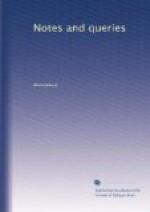Rufus.
* * * * *
Epigram on Louis XIV.—I find the following epigram among some old papers. The emperor would be Leopold I., the king Louis XIV.
Epigram by the Emperor, 1666, and the King of France.
Bella fugis, sequeris bellas, pugnaeque
repugnas,
Et bellatori sunt tibi bella
tori.
Imbelles imbellis amas, totusque videris
Mars ad opus Veneris, Martis
ad arma Venus.
J.H.L.
Macaulay’s Young Levite.—I met, the other day with a rather curious confirmation of a passage in Macaulay’s History of England, which has been more assailed perhaps than any other.
In his character of the clergy, Macaulay says, they frequently married domestics and retainers of great houses—a statement which has grievously excited the wrath of Mr. Babington and other champions. In a little book, once very popular, first published in 1628, with the title Microcosmographie, or a Piece of the World discovered, and which is known to have been written by John Earle, after the Restoration Bishop of Worcester and then of Salisbury, is the following passage. It occurs in what the author calls a character of “a young raw preacher.”
“You shall know him by his narrow velvet cape and serge facing, and his ruffe, next his hire, the shortest thing about him.... His friends, and much painefulnesse, may preferre him to thirtie pounds a yeere, and this meanes, to a chamber-maide: with whom we leave him now in the bonds of wedlocke. Next Sunday you shall have him againe.”
The same little book contains many very curious and valuable illustrations of contemporary manners, especially in the universities.
That the usage Macaulay refers to was not uncommon, we find from a passage in the Woman-Hater, by Beaumont and Fletcher (1607), Act III. Sc. 3.
Lazarillo says,
“Farewell ye courtly chaplains that
be there!
All good attend you! May you never
more
Marry your patron’s lady’s
waiting-woman!”
I.T.
Trin. Coll. Camb., March 16. 1850. {375}
St. Martin’s Lane.—The first building leases of St. Martin’s Lane and the adjacent courts accidentally came under my notice lately. They are dated in 1635 and 1636, and were granted by the then Earl of Bedford.
Arun.
* * * * *
CHARLES DEERING, M.D.
“Author of the Catalogue of Plants in the neighbourhood of Nottingham. ’Catalogus Stirpium, &c., or a Catalogue of Plants naturally growing and commonly cultivated in divers parts of England, and especially about Nottingham,’ 8vo. Nottingh. 1738.




